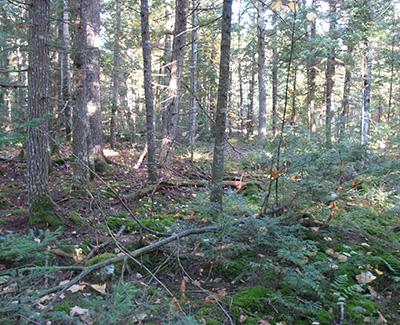How Silvicultural Treatments Affect Carbon Storage in a Northern Conifer Forest: A 60-Year Perspective

Concerns about climate change have increased interest in developing management strategies to maximize carbon storage in forests. Developing strategies for increasing carbon storage in forests is one of the foremost challenges facing natural resource professionals today.
NSRC researchers evaluated total ecosystem and harvested wood product carbon stocks among alternative forest management strategies (selection cutting, shelterwood cutting, commercial clearcutting, and no management) in mixed-species stands on the Penobscot Experimental Forest in central Maine. Forest management was initiated in the 1950s and has been maintained since. Researchers measured ecosystem carbon pools (live trees, dead wood, understory plants, and soils) in 2012 and used long-term data to determine carbon stored in below-ground dead roots, landfills, and harvested wood products.
Total ecosystem carbon stocks in the unmanaged reference stand were greater (247.0 ± 17.7 Mg ha-1) than that in managed stands (161.7 ± 31.3 Mg ha-1). Of the managed treatments, the commercial clearcut had the lowest total ecosystem carbon stocks by 21% on average, while the selection and shelterwood treatments had similar total ecosystem carbon stocks. Including the carbon stored in harvested wood products did not influence observed differences in carbon storage among treatments. When carbon stored in forest products was added to total ecosystem carbon stocks, total carbon stocks increased to 171.2 ± 31.7 Mg ha-1 for the managed stands. Findings highlight the impacts of long-term forest management strategies on carbon storage and indicate that the timing of harvests and the species and sizes of trees removed influence carbon stored in harvested wood products.
